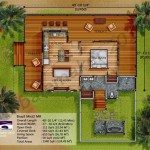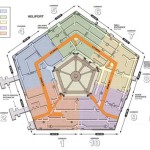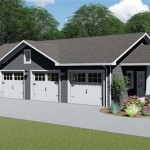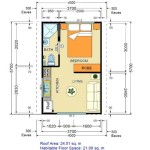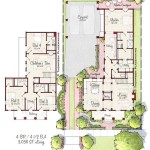3 Bedroom House Floor Plan With Dimensions
Choosing the right 3-bedroom house floor plan is a crucial step in the home building or buying process. A well-designed floor plan optimizes space utilization, enhances flow, and caters to specific lifestyle needs. Understanding the various layout options and considering detailed dimensions is essential for making informed decisions.
This article explores several 3-bedroom house floor plans, providing insights into their advantages, potential drawbacks, and typical dimension ranges. These examples serve as a starting point, offering a framework that can be further customized to individual preferences and specific site requirements.
Open-Concept Ranch Style
The open-concept ranch style has gained significant popularity in recent years. This layout typically features a combined kitchen, dining, and living area, creating a spacious and airy feel. Three bedrooms are typically situated along one side of the house, often sharing a hallway that leads to a common bathroom. Master suites, incorporating a private bathroom and walk-in closet, are increasingly common in this style.
Typical dimensions for an open-concept ranch might include a living area of 18ft x 15ft, a kitchen area of 12ft x 10ft, and bedrooms ranging from 12ft x 10ft to 14ft x 12ft. Master suites might range from 16ft x 14ft to 18ft x 16ft. The overall square footage can vary significantly, typically ranging from 1,200 to 2,000 square feet, depending on the size of individual rooms and the inclusion of additional features like a dedicated laundry room or a home office.
Advantages of this layout include improved social interaction, maximized natural light, and accessibility. Potential drawbacks include a lack of privacy and challenges in containing noise and odors from the kitchen.
Split-Level Design
Split-level designs offer a distinct architectural approach, dividing the house into multiple staggered levels connected by short flights of stairs. This layout typically places the living areas on the main level, with bedrooms situated on an upper or lower level. This design effectively separates private and public spaces.
Typical dimensions for a split-level house might include a living area of 16ft x 14ft, a kitchen area of 10ft x 12ft, dining area of 12ft x 10ft. Bedrooms, often located on a half-level above or below the main living area, can range from 10ft x 12ft to 12ft x 14ft. Overall square footage is comparable to the ranch style, typically ranging between 1,200 and 2,000 square feet.
Benefits of split-level designs include increased privacy, effective use of sloping lots, and a visually appealing architectural style. Potential drawbacks can include navigating stairs and potential heating and cooling inefficiencies.
Two-Story House Plan
Two-story house plans maximize vertical space, offering a clear separation between living areas and sleeping quarters. Typically, the main level comprises the living room, kitchen, dining area, and potentially a powder room. The upper level houses all bedrooms and bathrooms.
Typical dimensions for a two-story house might see a living room of 18ft x 16ft, a kitchen of 12ft x 12ft, and a dining area of 12ft x 10ft on the main floor. Upstairs bedrooms could range from 10ft x 12ft to 14ft x 16ft. Master suites in two-story homes often benefit from larger dimensions, potentially exceeding 18ft x 16ft. While the footprint might be smaller than a ranch, the added second story results in an overall square footage often exceeding 1,500 square feet and potentially reaching 2,500 square feet or more.
Advantages of the two-story design include increased privacy, greater square footage within a smaller footprint, and the potential for enhanced views. Drawbacks include the necessity of stairs, which can pose accessibility challenges, and potentially higher construction costs.
Considerations Beyond Dimensions
While dimensions provide crucial information, several other factors warrant consideration when selecting a 3-bedroom house floor plan. These include the location and size of windows, the placement of closets and storage areas, and the flow between different rooms. Careful consideration of these elements contributes significantly to the functionality and overall livability of the house.
Furthermore, local building codes and regulations impact permissible dimensions and layout options. Consulting with architects and builders is essential for ensuring compliance and navigating site-specific constraints.
Finally, personal lifestyle and future needs play a vital role in determining the most suitable floor plan. Families with young children might prioritize proximity of bedrooms, while those who frequently entertain might value a larger and more open living area. Considering these factors helps ensure the chosen floor plan aligns with long-term needs and preferences.
By carefully evaluating dimensions, considering various layout options, and reflecting on personal needs, individuals can select a 3-bedroom house floor plan that provides comfort, functionality, and lasting satisfaction.

Awesome Free 3 Bedroom Floor Plan With Dimensions And Review Plans House
3 Bedroom House Plans Three Design Bhk Plan Civiconcepts

Floor Plan For Small 1 200 Sf House With 3 Bedrooms And 2 Bathrooms Evstudio

Best Of 3 Bedroom Floor Plan With Dimensions And Description Plans Rectangle House

Beautiful Three Bedroom House Plans Blog Floorplans Com
Small House Design Ideas With Floor Plan 3 Bedroom Plans

3 Bedroom House Plans Modern Country More Monster

3 Bedroom Contemporary Home Design Pinoy House Designs Plans Bungalow Floor

Popular And Stylish 3 Bedroom Floorplans Plans We Love Blog Homeplans Com

3 Bedroom House Plan With Great Front View



